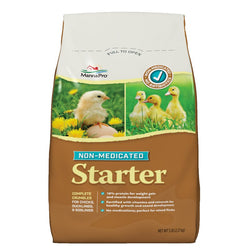How do I pick up a goose?
Back to blog
In a word--carefully! Geese are very strong animals, and you will want to learn to catch and hold them properly to avoid getting pummeled by their wings, bitten, or scratched. It's also important that you pick them up properly to keep the bird from being injured as well.
You'll want to avoid chasing geese over uneven, rocky, or otherwise dangerous terrain. Geese feet and legs can be injured, and you can be injured as well if you're not careful! Ideally, you will gently herd the goose into the corner of their pen or fence. You can use broom handles or sticks in each hand as "arm extenders" to make it easier to herd the geese into their pen.
To avoid hurting the bird, do not pick up geese or any other waterfowl by their legs. Instead, grab them firmly, without squeezing, just below their head. If the bird starts backing up, place their head under your arm to protect yourself from being bitten, and slide your other hand underneath their abdomen and secure both their legs with your thumb and index finger. Lift carefully, using your legs and not your back, keeping the bird's head firmly secured under your arm in such a way that it cannot bite you.
If the bird attempts to fight you with its wings, you might give up and try again the next day--and that would be okay unless you absolutely have to tend to that bird. If you must pick up the bird that day, you'll want to carefully grab both wings just above where they attach to their body.

Picking up a large, male Muscovie duck is similar to picking up a goose.
Geese that don't mind being picked up can simply be lifted by putting your hands on both sides of their body, holding the wings in place. It's always a good idea to keep the bird's tail facing away from you and the head away from your face. Even "friendly" geese may decide today's the day they don't want to be picked up and would rather bite your lip instead!
You'll want to avoid chasing geese over uneven, rocky, or otherwise dangerous terrain. Geese feet and legs can be injured, and you can be injured as well if you're not careful! Ideally, you will gently herd the goose into the corner of their pen or fence. You can use broom handles or sticks in each hand as "arm extenders" to make it easier to herd the geese into their pen.
To avoid hurting the bird, do not pick up geese or any other waterfowl by their legs. Instead, grab them firmly, without squeezing, just below their head. If the bird starts backing up, place their head under your arm to protect yourself from being bitten, and slide your other hand underneath their abdomen and secure both their legs with your thumb and index finger. Lift carefully, using your legs and not your back, keeping the bird's head firmly secured under your arm in such a way that it cannot bite you.
If the bird attempts to fight you with its wings, you might give up and try again the next day--and that would be okay unless you absolutely have to tend to that bird. If you must pick up the bird that day, you'll want to carefully grab both wings just above where they attach to their body.

Picking up a large, male Muscovie duck is similar to picking up a goose.
Geese that don't mind being picked up can simply be lifted by putting your hands on both sides of their body, holding the wings in place. It's always a good idea to keep the bird's tail facing away from you and the head away from your face. Even "friendly" geese may decide today's the day they don't want to be picked up and would rather bite your lip instead!











